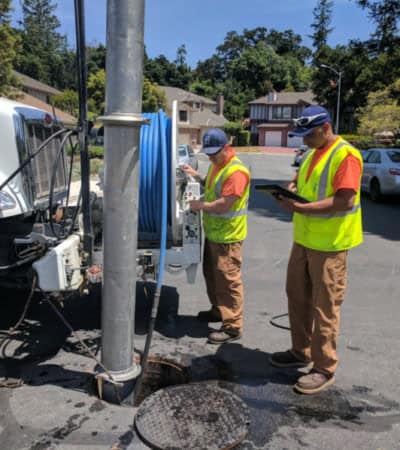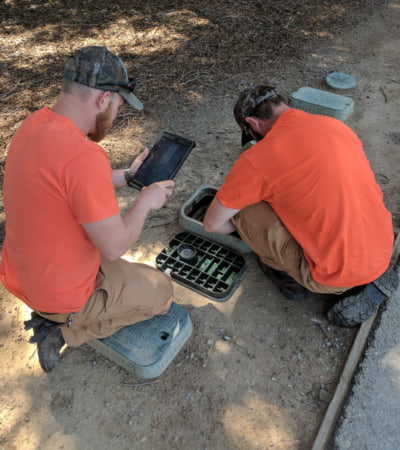Cupertino engaged an experienced Esri Business Partner, Quartic Solutions, to plan and deploy its ArcGIS Enterprise on AWS. The city moved from a single, internal server hosting ArcGIS and SQL servers to a multi-service AWS deployment.

A Winning Proposition
The City of Cupertino significantly improved the daily processes for its mobile workforce and streamlined the integration of its GIS and EAM in the field. While cloud computing is becoming the mainstream, many organizations are moving their on-premise GIS infrastructure to the cloud. The cloud offers many advantages to location-based applications by increasing underlying hardware’s scalability, flexibility, and deployment speed. At Cupertino, the decision to move their Esri Enterprise GIS system to Amazon Web Services Cloud (AWS) has been a winning proposition, and has reduced internal infrastructure administration costs, enabled better integration between their business systems, and increased the number of staff utilizing the multitude of new Esri cloud-based GIS tools, templates and solutions.
The City engaged an experienced Esri Business Partner, Quartic Solutions, to plan and deploy the City of Cupertino’s ArcGIS Enterprise on AWS. The city moved from a single, internal server hosting ArcGIS and SQL servers to a multi-service AWS deployment. One of the main forces behind the cloud migration was the City’s use of the Cityworks Enterprise Asset Management system (EAM). The City’s legacy architecture required field crews to check out data replicas daily or maintain a continuous VPN connection from ruggedized laptops. Both of these approaches were difficult to maintain and time-consuming for field crews, and they also required significant technical support from the GIS and IT departments.
By deciding to externalize the Esri map services and Cityworks geodatabases, the City could significantly improve the daily processes for its mobile workforce and streamline the integration of its GIS and EAM in the field. To alleviate security concerns, the City’s IT Department used an Amazon EC2 instance to separate the Esri ArcGIS services needed from its internal network. This architecture eliminated the need for a reverse proxy and increased the overall security of the City’s infrastructure.
The project has been so successful that it rapidly grew in scale and scope. With the mobile workforce editing GIS and EAM data securely in real-time in the field, the City’s utilization of GIS services grew. An RDS instance was added to handle the increasing database load, and the scale of the EC2 instance was increased several times to accommodate a growing number of map services and users as new departments implemented Cityworks.
Cupertino’s Former On-Premise Infrastructure
The City’s former infrastructure consisted of a single physical serverServer and SQL running ArcGIS Server Express. The SQL Server instance contained two databases, a geodatabase and the Cityworks database for work order management. This server was on the City’s network behind its firewall.
Field crews used one of two different products to manage assets. The first solution was an offline solution that allowed editing of GIS features. Crews would start the day by creating a checkout replica on their field tough books and head out to the field to do work. They’d return to the office and check in the replica. The checkout/check-in process was cumbersome and error-prone. It also resulted in crews spending more time in the yard and less time in the field.
The second solution used a wireless network with 4G connections and a VPN to connect to the city’s network. This solution was very dependent on network strength and could be very slow. Map pan and draw times would regularly time out, and edits to GIS features and work orders would be lost.

Stepping Into the Geospatial Cloud
With the professional services of Esri Business Partner Quartic, the City stepped into the Cloud infrastructure. The first step was to migrate from the primary existing on-premise server to a publicly accessible replicated AWS EC2 instance. As with the on-premise server, the EC2 instance contained the Esri ArcGIS Enterprise components and a SQL Server database.
Two-way geodatabase replicas were used to keep the internal and public geodatabases in sync. SQL Server contained two databases, one for Cityworks and a new geodatabase containing a subset of the feature classes of the main on-premise geodatabase. The subset consisted of all the public works feature classes that would be used and edited by Cityworks and the public works field crews. This allowed the field crews to update assets in the field while simultaneously allowing the GIS department to perform the more rigorous GIS edits when required.
The next step was to move the internal REST-based map services needed by the crews to the Cloud. Esri map services previously used by Cityworks from within the City’s network were recreated on the new ArcGIS Server installed on AWS. The transition was smooth, and the immediate results were very positive.
Field crews found their workflows greatly simplified, GIS needed less time assisting with the mobile units, and IT was happy with the security model, as none of the internal servers needed exposure to the outside.

Geospatial Cloud Supports Smart City Initiatives
GIS data and the Cityworks EAM software continued to grow as additional City Departments migrated to the new architecture. In addition, the Geospatial Cloud architecture enabled the City to build more and more beneficial web applications and easily make them available to the public. For example, the City’s 311 implementation was a tremendous success. As demand grew, an AWS RDS instance was required. The RDS instance is entirely within the AWS VPC, enabling ArcGIS Enterprise and Cityworks to continue controlling access.
With the boom in interest and spread of additional GIS solutions spurred by cloud architecture, the City has recently modified the maintenance process to push a full copy of the on-premise master geodatabase to RDS nightly. This allows up-to-date city reference data such as land base and planning data to be made available quickly and easily to the public through various smart city initiatives the city has implemented, such as tree information service and Esri open data portal. The City has also heavily utilized AGOL for internal reporting and metrics through public and private dashboards.
These AGOL services can easily pull City data from the AWS cloud into authoritative, focused apps used across the City. GIS data and the Cityworks EAM software continued to grow as additional City Departments migrated to the new architecture. In addition, the Geospatial Cloud architecture enabled the City to build more and more beneficial web applications and easily make them available to the public. For example, the City’s 311 implementation was a tremendous success.
Cloud Migration Results
Cupertino’s migration to a cloud platform continues to be a big success and is popular with stakeholders. Plans are to expand the approach to include more integration with the city’s network through OAuth and single sign-on. Even for smaller Cities such as Cupertino, migrating to Cloud infrastructure can profoundly impact staff’s ability to use GIS technology. Utilizing cloud infrastructure has streamlined internal operations and enabled the city to provide truly open data and government transparency to its citizens.


